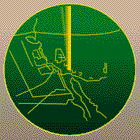Children stand in front of the blackboard in their Lancaster, Pa., school working on their arithmetic in this 1941 file photo. (AP/National Archives)
SAGE animation from Mitre
1963 modem, from SDCM
ARPANET 1971, from Atlas
NSFNET 1992, from Atlas
global MBone 1996, from Atlas
